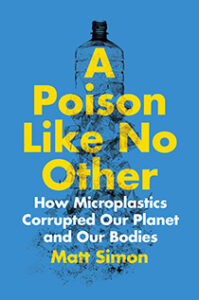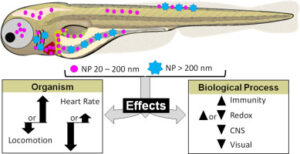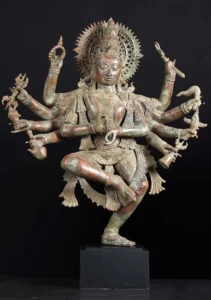Wired science journalist Matt Simon on his new book “A Poison Like No Other: How Microplastics Corrupted Our Planet and Our Bodies”. Julian Cribb author and science hunter: 10 game-ending threats to humanity.
Listen to or download this Radio Ecoshock show in CD Quality (57 MB) or Lo-Fi (14 MB)
MICROPLASTICS INVADE PLANET EARTH – MATT SIMON
What if I told you alien matter has invaded everything, everywhere. That is not science fiction or a conspiracy theory, but just an awful fact. Matt Simon is a science journalist with Wired Magazine. He just published his new book “A Poison Like No Other: How Microplastics Corrupted Our Planet and Our Bodies”. From San Jose California, we welcome Matt Simon to Radio Ecoshock.


Listen to or download my 33 minute interview with Matt Simon in CD Quality or Lo-Fi
“Microplastics” are pieces of plastic down to the size of an eraser on a pencil. You can pick these flecks up on almost any city street in the world (and in the Arctic). Microplastic particles break down into even smaller globs of plastic – most too small to see. These are “Nanoplastics”.
The fate of plastics is still so new that experts are debating terminology and the boundaries between microplastics and nanoplastics. Although those are a scale of size of the particles, each end of the scale behaves very differently as they breakdown into different chemicals and different interactions with living things.
Nanoplastics do not remain alone in the environment, plants or animals. Most nanoplastics collect a cover of biological molecules or even clay. This new chemical combination of nano-plastics and other molecules is called a “corona”. This coated complex of chemicals can then snowball into an aggregation of similar plastic-based nanostructures and their corona. So we ask “What is in a nanoplastic particle” as though it exists as an independent entity. The actuality in nature is a bewildering number of chemical combinations whose toxicity or benefits are unknown.
Nanoplastics are easily carried aloft in the wind. They have been documented in ice cores in both Greenland and Antarctica, far from human settlements. Dusan Materic and his colleagues called nanoplastics “ominipresent”. Nothing can clean up nanoplastics, and they can last hundreds of years. Microscopic life mistakes them for tiny fish eggs and eats plastic instead. In fact, all animals, birds and many other species have eaten so much plastic we can find bits of it in pretty well every organism big enough to see. Check out this illustration of plastic bits found in between skin cells of a Zebra fish.

Source: “Toxicity of nanoplastics for zebrafish embryos, what we know and where to go next“.
Nanoplastics can also cross the blood-brain barrier. It is likely both you and I have some plastic in our brains. But strangely, there has been no study on the human health effects of plastics getting into our bodies! Here is an article about plastics and human health. The science behind that helpful article is here.
In that study on plastics and human health, Mariana Teles et al. (From Universitat Autonoma De Baercelona, Spain) say:
“In the manufacturing process, several components, such as catalysts, solvents, stabilizers, flame-retardants or pigments, can be added to the nascent plastic polymers. During the plastic break down, these additives, some of which act as disruptors of endocrine pathways, may liberate to the surrounding medium, worsening the effects of plastic pollution.
All this wear and tear provide attachment surfaces for microorganisms, including pathogens, enhances the incorporation of plastic fragments into marine and terrestrial food webs, and, once bioaccumulated, may impair endogenous endocrine and neuroimmune crosstalk in vertebrates and invertebrates.”
Matt Simon writes:
“One study found that when exposed to sunlight, a sing[le]-use bag from Walmart spit out 15,000 compounds distinct from the compounds original to the plastic”.
These are too many bi-products to study, test or evaluate! Unknowing is built into this level of chemical complexity. So we are talking about evolutionary chemistry spraying out unknown chemicals with unknown and untested impacts on living things. A Walmart bag becomes a chemical factory, one among trillions out there on land and sea.
We know there is lots of plastic in our guts. One study estimated globally, each of us ingests about a credit card weight of plastic every week! About 90% of that plastic goes out through our bowel as waste. I guess the other 10% becomes incorporated in our bodies. That means that seniors born before the Great Age of Plastic Everything ( the “plasticene”) – have less plastic in us than young people will at our ages. It is another unfair burden, or plastic debt, left on the next generation and all who follow.
There are a wide range of plastics that break down in different time periods. But most last at least years, some thousands of years (we think). That means there is plastic “toxicity debt” – the time decades or more from now when all the plastics we throw out now begin to release their toxic particles (some from additives) and greenhouse gases. We off-loaded the pollution hit into future generations – even with plastic!
PLASTIC RECYCLING IS A DANGEROUS DELUSION
On land, forget the delusion that plastic you put out in those bins is actually being recycled. Only about 5% of plastic waste intended for recycling actually gets there. The rest ends up in landfills or … somewhere. That is partly due to the capitalist system which fails on environmental waste. It is cheaper to make more new plastic beads than to collect, clean and remake plastic from recycled materials. So they keep on making billions of tons of new plastic, even though it has nowhere to go in the environment.
Check out this new Greenpeace USA report on plastics “Circular Claims Fall Flat Again” published 10-24-2022.
In his book “A Poison Like No Other”, Matt Simon writes:
“Every step of manufacturing virgin plastic also expels greenhouse gases….
According to the group Beyond Plastics, production is expanding so rapidly that by 2030, emissions from plastic production will overtake greenhouse gases from coal.
So really, plastics are canceling out the gain humanity has been making on climate change by decommissioning coal plants and electrifying vehicles.”
42 new plastic making plants are coming online or in the works, Simon writes. Obviously plastic recycling is not working at all.
AN OCEAN OF PLASTIC
The story is worse in the sea. To degrade at all, plastic needs to be hit by UV rays from the Sun. Once plastic sinks, it lasts for a very long time indeed. The sea bottom as deep as the Mariana Trench already has plastic bits. Deep sea creatures, and all the fish above them, are eating plastic. That reduces the amount of real food, weakening the creatures.
A 2021 study looking at over 170,000 individual fish found two thirds of them had microplastics in them. And as Joseph Winters writes in Grist “All That Plastic In the Ocean Is A Climate Change Problem Too”.
THE UNKNOWN HEALTH THREATS IN ALL THIS PLASTIC
Plus, the toxic chemicals baked into plastics can lead to cancer, heart disease, and much more.
As Matt Simon tells us, there are several different kinds of plastic. Nobody knows what is in that chemical brew made by chemical factories all over the world. Some add herbicides or pesticides to protect the final plastic product. Or the manufacturer may add very toxic materials, many chlorinated, to get certain properties, whether flexibility, hardness, or whatever. They do not publish the ingredients. Even though we are eating plastic with our food, breathing it, and drinking it, the public does not know what is getting into our bodies. It is indeed “a poison like no other.”
PLASTICS AND CLIMATE CHANGE
As Matt tells us, plastics are just fossil fuels in another guise. In fact, there is some evidence the big fossil fuel companies realize their days of selling gas, coal and oil to burn are getting limited by climate concerns. They hope to stay in business providing fossil fuels for the plastic industry.
That is just one climate link. Because plastics are mainly fossil fuels, when they do finally break down, they release carbon dioxide and methane back into the atmosphere. That is going on every day.
Finally, tiny particles of plastic, including nano-plastics, are floating around in the clouds. They can form the gathering point for rain drops, enabling more extreme rainfall instead of a gentle rain. We are seeing a lot of such extreme precipitation events. There is some discussion whether the billions (probably trillions) or plastic particles in the atmosphere (e.g. the air we breath) – whether they reflect some sunlight back into space. If so, the unseen plastic haze may slightly cool the planet, or at least dial back even more extreme heat. I’m still waiting to see great science on this.
Either way, we can’t kick the deluge of toxic plastics to one side while we fight climate change. They are the same battle, with the same basic solution: keep fossil fuels in the ground. Basically, to write this book Matt Simon has to investigate the whole world. That is where microplastics are.
In the radio interview we focus on:
the human gut – and the gut’s relationship to the brain;
microplastics in the ocean food chain
the many ways microplastics could influence climate change. This is a cool interview with a good speaker and journalist. Check it out.
ALSO BY MATT SIMON
Wired Magazine: “The World Is Drowning in Plastic. Here’s How It All Started” October 27, 2022.
=====================================================================
THE DARK SIDE FROM DOWN UNDER – JULIAN CRIBB
“Here comes the catastrophocene”. So says one of Australia’s most experienced science journalists Julian Cribb. Julian was science editor for the country’s only national daily newspaper “The Australian”. He wins awards and helps top agencies communicate science. Cribb is co-founder of the non-profit Council for the Human Future. He is author of the book “Surviving the 21st Century: Humanity’s Ten Great Challenges and How We Can Overcome Them”.
Listen to or download my 28 minute interview with Julian Cribb in CD Quality or Lo-Fi
For years Julian toiled over: “the self-inflicted existential emergency faced by humanity.” He wrote six books, published over 8,000 articles and edited even more. But Julian’s conclusion is hard to hear, and hard to grasp. We face a lot of very dangerous threats – in fact 10 major existential threats. That is, if we manage to master or defuse six great threats to human civilization, the other four left undone could still crash us out of civilized life, and maybe even survival as a species.
The ten threats we discuss in the interview are:
Eco-collapse, overheating, toxic poisons, and nuclear holocaust.
These first four mega-threats could develop on different time scales. For example, mass extinction and overheating might take hundreds of years. But civilization could be wiped out very quickly by an exchange of nuclear weapons. Does the speed of threats help us choose priorities?
We just heard from Matt Simon, author of a new book about poisonous plastics invading everything on the planet. Julian Cribb wrote the book “Poisoned Planet “ in 2014. So toxic materials get their own place in his top ten list, right up there with nuclear war and climate change.
Next three mega-threats: resource scarcity, pandemics, and overpopulation
The final three are: three threats are famine, ultra-technologies, and misinformation.
“Ultratechnologies” would include things like Artificial Intelligence and many other mass experiments now playing out in our society. Misinformation, has boomed in recent years. I think this could help do us in, because misinformation leads to bad decisions and sometimes terrible results, like violence. Is it possible truth itself is no longer able to penetrate the fog of lies told to us, and that we tell ourselves?
In his book, Julian did not include civilization-enders like an asteroid strike, solar storms or chains of volcanic eruptions. His focus is on threats we make against ourselves.
This past summer Cribbs wrote the ten catastrophic risks can only be solved if women assume leadership everywhere – in business, politics and religion. If that is true, and I don’t disagree, that sounds like we are doomed. All of those fields, religions especially, they specialize in protecting and projecting male power. Do you really think that can be changed?
NEEDED: A NAME AND IMAGE FOR THE DECA-THREATS
I am wrestling with how a complex matrix of ten threats, all too dire to leave unattended, can be understood by the public. An image to project the ten faces of failure would be helpful. I thought of the Indian Hindu image of the Deity Shiva, known as “the destroyer”. Some statues of Shiva show him/her with ten arms, like the ten forces we need to overcome. The image is powerful and well-known, but we cannot culturally appropriate a symbol so divine to countless millions of people. Is there some way to picture the complex of ideas Cribb describes to us?

Julian Cribb also co-founded Council for the Human Future, a non-profit research group in Australia. In August 2022 Julian presented to the Canadian Association for the Club of Rome. His presentation “Our Existential Crisis” is available on YouTube. And watch for Julian’s new book coming out in a month or so. It is called “How To Fix A Broken Planet”.
THANKS FOR SUPPORTING RADIO ECOSHOCK
This show tries to get you the voices of authors, scientists and activists straight from their own mouths. Our guests get time to talk, explain and explore – without any advertising. I don’t bug you with annoying pop-ups or ads from Chevron on this site either. All costs get paid by our listeners – like you. You can help at any level you can afford. Check out your options here.
As always, thank you for listening, and caring about our world.
Alex
Julian Cribb is an absolute giant living legend for the environmental movement, but I am sure he would rather just be an ordinary peasant if it meant that national leaders had seen thru the decades of smoke & mirrors disinformation from BigOIlGasCoal (& GiantAgriChem).
If they had instead heeded the stream of advice from climate scientists & implemented the essential mitigation measures decades ago, we would not be on today’s slippery slope.
The climate deniers have shot themselves in both feet & are now peering down the barrel in a situation of their own making.
Pingback: Nuclear news in this COP27 week | Nuclear Australia
This Vonnegut inspired dystopian novella mentions nanoplastics crossing our blood brain barriers, along with many other drivers of our impending doom, disguised as gallows humor.
full pdf of novella https://www.dropbox.com/s/nio185d72vkqkpc/ChannellingTrout_full_compressed.pdf?dl=0
reading of excerpts: https://www.youtube.com/watch?v=MwwY2c16I4w
Joe – thanks for those good tips. I was not aware of the Vonnegut work.
This is the centenary month and year of Kurt’s birth, a time to celebrate his memory and strong antiwar and proenvironmental advocacies.
(please note my correct email address here, previous one no longer valid)